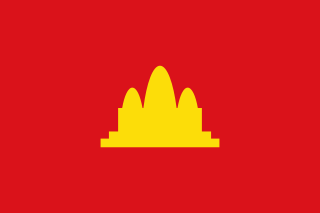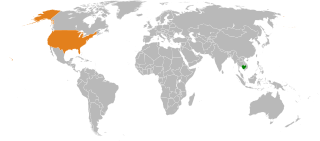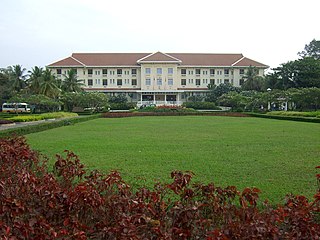

The Hotel Le Royal is a hotel located in Daun Penh District, Phnom Penh, Cambodia. It was first established in 1929. It is today operated by Raffles Hotels & Resorts.


The Hotel Le Royal is a hotel located in Daun Penh District, Phnom Penh, Cambodia. It was first established in 1929. It is today operated by Raffles Hotels & Resorts.
In late 1923 and early 1924, the construction of a 55-room hotel in Phnom Penh was proposed, with Ernest Hébrard as architect and the help of Jean Desbois for the design. A visionary planner, he played no small part in turning a Cambodian-French colonial outpost into a bustling and dynamic metropolis.
The Phnom Penh proposal also outlined the construction of 40-room hotels in Siem Reap and Hué (Vietnam). The tourist potential of the Angkor ruins had not gone unnoticed. Included in the initial proposal were preliminary estimates for buildings and furnishings for five sites. Costs were presented in the currency of Indochina at the time, the ‘piastre’ or Indochina dollar. It is evident that the highest priority was given to the future hotel for Phnom Penh.
An integral part of Hébrard’s plan was to partially fill in a canal that encircled Phnom Penh’s European Quarter, plant extensive gardens, extend the city to the other side of the Tonle Sap River, create a new central market and, construct a new hotel to be managed by the Society for Grand Hotels of Indochina.
The official opening, attended by HM Sisowath Monivong (reigned 1927-1941) and a host of expatriate guests took place on the evening of 20 November 1929. The party included a lavish buffet, dancing and performances by an orchestra brought especially from what was then Saigon. The Director of the hotel between 1929 and 1931 was M.L.F. de la Pousardière. On 22 December 1931, L’Echo du Cambodge announced the departure of M La Pousardière and a new direction for Le Royal under the supervision of M. Jean Baluteig.
Today, the street immediately alongside the hotel bears the name of the King, Preah Monivong Boulevard. The original name of the street in front of the hotel has changed several times through the years. Originally Avenue du Maréchal Joffre, it became Pologne Street (Street 92) and is now known as Rukhak Vithei Daun Penh.
The hotel itself has had several name changes. From its inception in 1929 it was named ‘Le Royal’. Between 1970 and 1975, during the Khmer Republic period, it was known simply as ‘Le Phnom’ and was a popular refuge for journalists covering the Cambodian Civil War. In April 1975, the Red Cross sought to establish the hotel as a neutral zone, however, with the Fall of Phnom Penh on 17 April 1975, the Khmer Rouge emptied the hotel and its grounds. [1] After the fall of the Khmer Rouge in 1979, it was reopened as ‘Hotel Samakki’ (Solidarity Hotel). This name was used until HM King Father Norodom Sihanouk was reinstalled in 1993, when the hotel reverted once again to ‘Hotel Le Royal’.

Phnom Penh is the capital and most populous city of Cambodia. It has been the national capital since the French protectorate of Cambodia and has grown to become the nation's primate city and its economic, industrial, and cultural centre. Before Phnom Penh became capital city, Oudong was the capital of the country.

Norodom Sihanouk was a member of the Cambodian royal house who led the country as King and Prime Minister. In Cambodia, he is known as Samdech Euv. During his lifetime, Cambodia was under various regimes, from French colonial rule, a Japanese puppet state (1945), an independent kingdom (1953–1970), a military republic (1970–1975), the Khmer Rouge regime (1975–1979), a Vietnamese-backed communist regime (1979–1989), a transitional communist regime (1989–1993) to eventually another kingdom.

The Kingdom of Cambodia, also known as the First Kingdom of Cambodia, and commonly referred to as the Sangkum period, refers to Norodom Sihanouk's first administration of Cambodia, lasting from the country's independence from France in 1953 to a military coup d'état in 1970. Sihanouk continues to be one of the most controversial figures in Southeast Asia's turbulent and often tragic postwar history. From 1955 until 1970, Sihanouk's Sangkum was the sole legal party in Cambodia.

Ernest Hébrard (1875–1933) was a French architect, archaeologist and urban planner, best known for his urban plan for the center of Thessaloniki, Greece, after the great fire of 1917.

French was an official language of Cambodia for over a century, from the establishment of the French protectorate in the mid-19th century to the start of the Khmer Rouge regime in 1975. Cambodia is the smallest of the three Francophone communities in Southeast Asia, the others being Vietnam and Laos. Out of all Asian Francophone nations, Cambodia is where French has declined the most since the end of the Indochina Wars. Nevertheless, French remains an administrative and cultural language in the country.
Long Boret was a Cambodian politician who served as the last prime minister of the Khmer Republic from 26 December 1973, to 17 April 1975. Highly regarded for his honesty, he tried unsuccessfully to negotiate a peace settlement with the Khmer Rouge during the Cambodian Civil War. He was later arrested by the Khmer Rouge and executed. He is one of two prime ministers to die in office, the other being Chan Sy. He is also the longest serving prime minister under the presidency of Lon Nol for the Khmer Republic.

Democratic Kampuchea was the official name of the Cambodian state from 1976 to 1979, under the government of Pol Pot and the Communist Party of Kampuchea (CPK), commonly known as the Khmer Rouge. The Khmer Rouge's capture of the capital Phnom Penh in 1975 effectively ended the United States-backed Khmer Republic of Lon Nol.

Operation Eagle Pull was the United States military evacuation by air of Phnom Penh, Cambodia, on 12 April 1975. At the beginning of April 1975, Phnom Penh, one of the last remaining strongholds of the Khmer Republic, was surrounded by the Khmer Rouge and totally dependent on aerial resupply through Pochentong Airport. With a Khmer Rouge victory imminent, the US government made contingency plans for the evacuation of US nationals and allied Cambodians by helicopter to ships in the Gulf of Thailand. Operation Eagle Pull took place on the morning of 12 April 1975 and was a tactical success carried out without any loss of life. Five days later the Khmer Republic collapsed and the Khmer Rouge occupied Phnom Penh.

Norodom Boulevard, also called Street 41, is a major boulevard in Cambodia and one of Phnom Penh's oldest arterial roads. It was named after King Norodom. It connects with Monivong Bridge in the south-east of the city at the Bassac River and joins with the north of the city at Wat Phnom.

Bilateral relations between the United States and Cambodia, while strained throughout the Cold War, have strengthened considerably in modern times. The U.S. supports efforts in Cambodia to combat terrorism, build democratic institutions, promote human rights, foster economic development, and eliminate corruption.

Chau Sen Cocsal, also known as Chhum, was a Cambodian civil servant and politician who served as Prime Minister of Cambodia in 1962 and President of the National Assembly twice, in 1962–1963 and 1966–1968. Chhum was awarded the honorary title "Samdech" in 1993 by King Norodom Sihanouk.

The Central Market is a market and an art deco landmark in Phnom Penh, the capital of Cambodia. The bright yellow building completed in 1937 has a 26-metre high central dome, with four tall arch-roofed arms branching out diagonally across the block, creating vast hallways housing countless stalls and a variety of goods. Initially designed by city architect Jean Desbois, construction works were supervised by French architect Louis Chauchon. When it first opened in 1937, it was said to be the biggest market in Asia; today it still operates as a market.

Sisowath Monipong was the second son of the former King of Cambodia, Sisowath Monivong and Princess Norodom Kanviman Norleak Tevi. He took part in Cambodian politics during and after World War II.

Christ the King Cathedral, also known as the Cathedral of Phnom Penh, was a 19th-century French Gothic revival church that served as the cathedral of the Apostolic Vicariate of Phnom Penh. It was located in the Russei Keo District of the city on Monivong Boulevard.

Cambodian genocide denial is the belief expressed by some academics that early claims of atrocities committed by the Khmer Rouge government (1975–1979) in Cambodia were much exaggerated. Many scholars of Cambodia and intellectuals opposed to the US involvement in the Vietnam War denied or minimized reports of human rights abuses of the Khmer Rouge, characterizing contrary reports as "tales told by refugees" and US propaganda. They viewed the assumption of power by the Communist Party of Kampuchea as a positive development for the people of Cambodia who had been severely impacted by the Vietnam War and the Cambodian Civil War. On the other side of the argument, anti-communists in the United States and elsewhere saw in the rule of the Khmer Rouge vindication of their belief that the victory of Communist governments in Southeast Asia would lead to a "bloodbath."

The Fall of Phnom Penh was the capture of Phnom Penh, capital of the Khmer Republic, by the Khmer Rouge on 17 April 1975, effectively ending the Cambodian Civil War. At the beginning of April 1975, Phnom Penh, one of the last remaining strongholds of the Khmer Republic, was surrounded by the Khmer Rouge and totally dependent on aerial resupply through Pochentong Airport.
The following lists events that happened during 1975 in Cambodia.

Raffles Grand Hotel d'Angkor is a historic hotel located in Siem Reap, Cambodia. First opened in 1932, it was established by French town planner Ernest Hébrard to accommodate the early explorers and tourists visiting the world heritage site Angkor Wat.
The Embassy of France in Cambodia is the primary diplomatic mission of the French Republic to the Kingdom of Cambodia. It is located in the capital Phnom Penh. It is known for the role it played as a place of refuge for foreigners and at-risk Cambodians after the Khmer Rouge takeover for several days until foreigners were forced to go to Thailand while the regime forced Cambodians to stay in the country.
Jean Desbois was a French architect who rose to fame during the 20th century and left significant landmarks in France and in Cambodia such as the Central Market in Phnom Penh.
William Warren, Jill Gocher (2007). Asia's legendary hotels: the romance of travel. Singapore: Periplus Editions. ISBN 978-0-7946-0174-4.